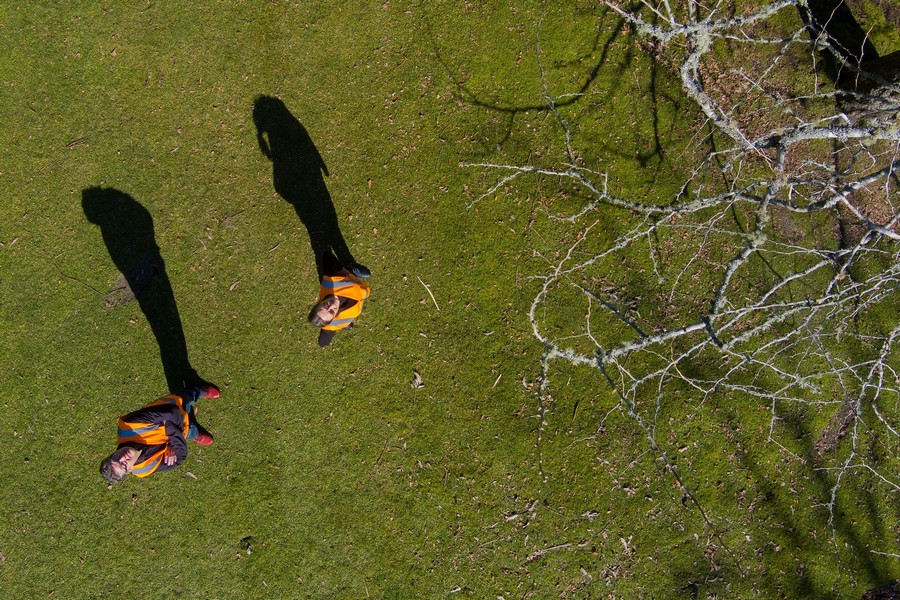UAVs for pest control take off
For immediate release
13 February 2024
As climate change increases the risk of invasive pests reaching our shores and affecting New Zealand’s multibillion-dollar primary sector, Scion researchers are hopeful a burgeoning tool could provide a more efficient urban biosecurity solution.

Scion’s Plant Protection Physics and Chemistry team lead Dr Justin Nairn says using unmanned aerial vehicles (UAVs) could be a new tool in the biosecurity toolbox making pest control more targeted, safer and less invasive. UAVs can fly closer to the target than a helicopter − about 2m versus 10m-plus − have a smaller footprint and fly slower meaning they can be more precise.
The research comes two years since the discovery of the fall armyworm in New Zealand in February 2022. The moth threatens crops in its larvae (caterpillar) stage.
Nairn’s initial studies in March 2021 into the general efficiency of spraying using UAVs used fluorescent dye to investigate how UAVs performed in aerial spray operations in urban environments.
Then in February last year, one year after fall armyworm’s arrival, scientists trialed using a key bio-insecticide for combating Lepidoptera moths. The findings of this trial are being finalised but Nairn says using UAVs for pest control is growing quickly as operational limitations like cost, weight and flight time are reducing as technology advances.

Scion has been involved with pest incursion responses and field research in aerial spray methodology for decades looking for new, more targeted ways to tackle pest and insect outbreaks.
The invasive pest problem has been highlighted many times over the years. From a seven-year, $65 million response to the painted apple moth in Auckland in 1999, through to the ongoing battle against fall armyworm and managing myrtle rust.
Fast and effective pest control is vital to prevent pest and pathogen establishment. However there needs to be a balance between engaging communities ahead of incursion responses, and the potential need for fast action, Scion social scientist Dr Andrea Grant says.
“If community concerns are not addressed and they have no opportunity to respond to planned operations, they may lose confidence and support for urban biosecurity operations in future.”
In aligned research, Grant ran focus groups looking at social and cultural considerations of UAV spraying. They included social researchers, UAV researchers, Māori involved in forest protection and management, and forestry managers. Participants identified social issues like human health, safety and ethics, professionalisation of UAV use, Te Tiriti partnerships, engagement and capability.

Grant and her collaborators also held a co-design workshop where participants noted the role for mātauranga Māori and need to work with Māori alongside key agencies in research, policy, operations and ethical aspects of co-design.
Māori environmental not-for-profit Te Tira Whakamātaki was included in focus groups. Chief scientist Dr Simon Lambert says much of the Māori economy is in the primary sector so highly reliant on the environment.
“Māori are increasingly aware of the vulnerability of their assets and cultural capital to biosecurity events and are not opposed to technological innovation but insist on early and ongoing engagement.”
Better Border Biosecurity (B3) is a multi-partner joint venture researching ways to reduce entry and establishment of new plant pests and diseases in New Zealand.
B3 Director Dr Desi Ramoo says Nairn’s research is an example of adapting existing technology into an applied biosecurity tool.
“We must be prepared with a number of solutions developed from Western science and mātauranga Māori to ensure we are ahead of the game and move from a reactive to proactive biosecurity system.”
Brendan Gould, Forest Owners Association biosecurity manager, says successful intervention relies on the ability to respond, but community impacts and implications need to be considered as part of the process of operational design.
"There is no one tool that will work in every situation.”
He says engagement before an incursion is important but challenging when immediate action is needed. Scion’s research allowed for pre-engagement to be considered.
Nairn’s work was part funded by Better Border Biosecurity while Grant’s was part funded by Forest Growers Research Trust. Both received Strategic Science Investment Funding.
ENDS

